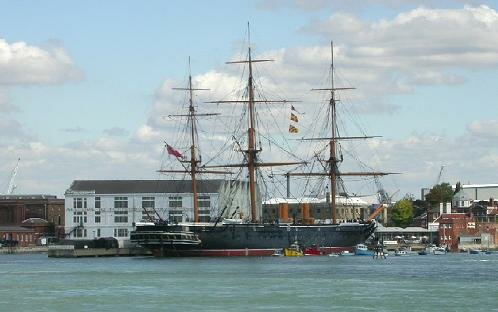The Thames Ironworks
In 1856, the Thames Ironworks and Shipping Company was founded at Bow Creek. The company was previously known as C.J. Mare and Company who were forced out of business by financial difficulties. By then many large ships had already been constructed at Bow, mainly of wood and iron.
Soon after its formation, the Thames Ironworks and Shipping Company received an order from the British Admiralty to construct what was to become the largest warship afloat, and the first sea-going ironclad in the world. The vessel was powered by both sail and steam and was launched in 1860, and was named HMS Warrior, which is now preserved at Portsmouth.

It is difficult to imagine that large scale manufacturing industries such as iron works and shipbuilding were operating at the southern end of the River Lea in the 1800s. During its heyday, marine engines, motor cars, locomotives, buses, cranes, electrical and civil engineering equipment were all produced by the company,
In 1877, a most unusual contract was placed with them. They were asked to construct an iron cylinder 15ft in diameter and 92 ft long to transport Cleopatras obelisk, or needle, from Egypt to London. The obelisk was finally erected on the Victoria Embankment next to the river Thames in 1878, were it still stands today.
In 1912, the works closed due to a lack of orders from the British Admiralty.
It is said that the works also supplied the iron plates for the construction of Isambard Kingdom Brunels Great Eastern, the worlds largest ship, which was launched from John Scott Russells Millwall yard in 1858, only about a mile distance from the Thames Ironworks.
Today, the memory of the Thames Ironworks still lives on in the form of West Ham United Football Club, whose badge emblem is two crossed hammers in memory of the formation of the club at the works in 1895.
HMS Warrior, Portsmouth: the Worlds First Iron Clad Warship
HMS Warrior, a 9137-ton ironclad frigate, was built at the Thames Ironworks shipyards at Bow Creek in east London in the latter half of the 19th century. The first of the Royal Navys many ironclad capital ships, she entered service in October 1861, somewhat over a year after the completion of the French battleship Gloire opened an international competition in armoured warships that was to continue for over eight decades.

Warrior was assigned to the Channel Fleet, in which she spent nearly all of her seagoing service guarding Britain and the eastern Atlantic against potential maritime threats. The routine of this duty was punctuated by a collision with HMS Royal Oak on 14th August, 1868, and special service towing a large floating dry-dock to Bermuda in mid-1869.
Warrior had her gun battery upgraded during a refit in 1864-67 and received other modifications in 1872-75. After the latter dockyard period, she was in reserve service until 1883, making summer cruises in waters from Gibraltar to the Baltic and receiving occasional temporary assignments with the Channel Fleet. From 1883 until about 1900, the ageing ship, now reclassified as an armoured cruiser, was laid up, though available for recall to combatant duties.
Beginning in 1901, Warrior was employed as a storage and depot ship for torpedo vessels at Portsmouth and was attached to the torpedo school, HMS Vernon, from 1904 to 1923. She was renamed Vernon III during most of this time, but regained the name Warrior at the end. After attempts to sell her for scrap produced no purchasers, in 1927-29 the ship was converted to an oil facility mooring hulk at Pembroke. She again lost her name during World War II, but continued her modest employment into the 1970s. By this time, her value as a unique historic relic was widely recognized and in 1979 she was transferred to the Maritime Trust for preservation as a museum.




